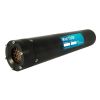Pro-Oceanus Solu-Blu TDG Probe
Features
- Provides continuous 24/7 TDG monitoring
- Not affected by increasing hydrostatic pressure
- Designed for aquaculture, dam spillways, groundwater monitoring, etc.
- Expedited repair and warranty service
- Lifetime technical support
- More
Overview
The Solu-Blu total dissolved gas (TDG) probe can be used for long-term continuous in-situ monitoring to provide reliable dissolved gas pressure measurements. It provides accurate TDG pressure data and is designed for use in aquaculture, dam spillways, groundwater monitoring, and industrial applications. Solu-Blu TDG probe is not affected by increasing hydrostatic pressure. It can be used in a range of liquids ranging from fresh- and salt water to industrial fluids such as oil or hydraulic fluid.
Mechanics
The measurement of all gases dissolved in a liquid is facilitated by a semi-permeable membrane that allows gases to transfer from water into a gas head space where the measurement is made.
For air pressure compensation, the sensor uses a vented cable with a barometric pressure sensor inside the housing. This pressure is then used in calculating the % Saturation. When using the RS-232 signal, both the dissolved gas pressure and the barometric pressure are output in the data string.
| Sensor Performance | |
|---|---|
| TDG Pressure Range | 800-1300 mbar Absolute 75-150% Saturation *other ranges available |
| Accuracy: | ± 0.1% (Temperature compensated from 0 to 50º C) |
| Equilibration rate (t63): | Dependent on gas composition |
| Resolution | 0.1 mbar 0.1% Saturation level |
| Physical | |
|---|---|
| Length | 20 cm (8 in) 26 cm with connector |
| Diameter | 5 cm (2 in) |
| Weight | 0.28 kg (0.6 lbs) |
| Housing Material | Acetal Plastic |
| Depth Rating | 0 - 50 meters |
| Water Temperature | -2º to 40º C |
| Electrical | |
|---|---|
| Input voltage | digital: 7-24 VDC analog: 12-24 VDC |
| Power consumption | 0.04 W (3.5 mA @ 12 V) |
| Data output | RS-232, ASCII format 0-5 V or 4-20 mA |
| Sample rate | 1 second |
In The News
From Hurricanes to Florida’s Red Tides: Monitoring the Southwest Gulf Coast
Nearly every year, southwest Florida is blighted by harmful Karenia brevis blooms–known colloquially as Florida red tides. These harmful algal blooms (HABs) form over the West Florida shelf and are pushed shorewards by winds and currents. Once in touching distance of the coast, they often intensify, fed by land-based runoff, anthropogenic nutrients, and decomposing marine life killed by toxins produced by these red tides. Red tides have become more severe and persistent over the past 20 years, causing major environmental and economic damage.
Read MoreWave-Powered Buoy Deployed in Puget Sound
While the development of solar-powered monitoring systems has improved access to real-time environmental data, solar power is still limited by low light conditions, such as poor weather, nighttime, or high-latitude environments. To supplement these incumbent power solutions at sea, Ocean Motion Technologies has developed a small-scale ocean wave energy system that can be directly integrated with existing data buoy platforms. Not only does wave energy supplement solar power during periods when the buoys are limited by light availability, but it also allows data buoys to perform beyond their current power capacities.
Read MoreLong-Term Monitoring in the Chautauqua Lake Watershed
With a widely developed shoreline, Chautauqua Lake experiences influxes of non-point source pollution that have historically impacted the health of the lake. The Chautauqua Lake Association (CLA) has been monitoring the lake for over two decades, reporting on changes that have occurred over the years. A pair of local lake advocates, Jane and Doug Conroe, have lived on the lake for over 40 years and have played an important role in establishing monitoring programs and facilitating consistent data collection throughout the watershed. Doug has been involved with the Chautauqua Lake Association (CLA) since the pair moved to the area in 1980, and is currently serving as the Executive Director.
Read More

















